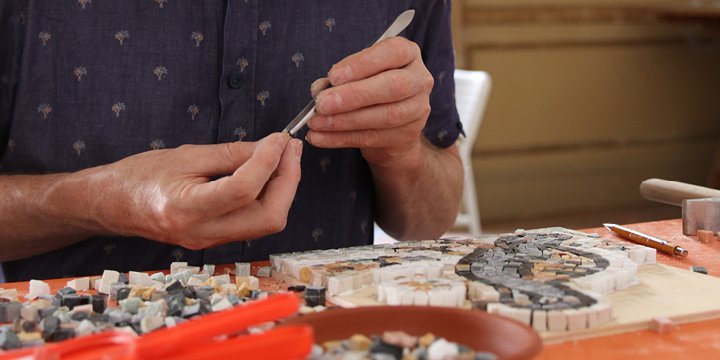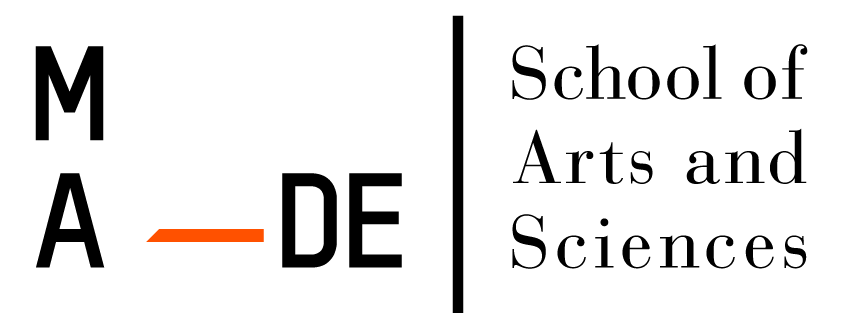
Studying Fine Arts and Design at MADE means learning from creative professionals, working in top level MADE studio spaces, and drawing inspiration from the Mediterranean Basin. Consider the constantly changing role of visual arts and technological transformations in our culture and develop your understanding of practical techniques and processes.
Fine Arts & Design Track
MADE aims to work at the crossroads of design, art, traditional crafts, and local culture. Designed for both fine arts & design and non-fine arts & design majors, this program offers the students a multifaceted experience through a diverse array of accredited programs covering everything from Design (including Graphic, Fashion, Sound, Product, Interior, Set Design, and Urban Planning) to Fine Arts, such as Painting, Drawing, Sculpture, Videomaking, and Photography. This track is strongly integrated with the MADE BA Programs in Design, Visual Arts, and Fashion, allowing study abroad students to take classes and learn alongside Italian students in English.
Teaching Course List — Spring 2026
For the editors: you can edit and adjust this list here. The order is now based on the code, with priority to mandatory courses.
| Italian Language & Culture (ITAL / SOC 151 , mandatory course) | Each student will complete an intensive Italian Language and Culture course. By beginning the term with an intensive 4-week Italian Language and Culture course, students are prepared for more meaningful engagement with their environment. Students will explore Italy’s history, culture, and language, both through lectures and local site visits. By developing an understanding of the unique historical and cultural context of Sicily as well as key Italian words and phrases, students are empowered to interact with the local community in a respectful and meaningful way. With this groundwork in place, students will be set up for success to engage with all that Sicily has to offer and to set themselves apart by completing their MADE program. Italian classes are offered at all levels, from A1-C2, and a placement exam is offered online, pre-departure. Detailed descriptions for each level of Italian language can be found below. This course is required for all MADE semester study abroad students. |
| Directed Undergraduate Research (RES 250, mandatory course) | The Directed Undergraduate Research course provides MADE students with a foundation in interdisciplinary research methodologies and theoretical frameworks. Through ethical data collection, qualitative and quantitative methods, and literary reviews, students develop research skills. With mentorship from industry experts, they pursue individual projects, integrating Sicily’s unique resources. |
| Environmental Art: Unraveling Cartographies (ARTS / ENV 257) | Unraveling Cartographies is a field research-based course combining art and alternative mapping methods to explore human impact on the environment. Focusing on the Augusta-Priolo-Melilli area, students will use sensory art and participatory cartography to map landscapes, memories, and socio-political dynamics, culminating in a collective publication or multimedia installation. |
| Sustainable Food Systems in Sicily (ARTS / ENV 261) | Food serves as a link between the body and the landscape, shaping our connection to the environment. This site-based course explores sustainable food practices in contemporary Sicily, including local production, zero waste, and organic agriculture. Students analyze sustainability from multiple perspectives and develop a personal creative narrative, contributing to a collective experiential dinner design. |
| Decolonizing Iconography (ARTS / HIST 306) | This course explores visual culture through decolonial and postcolonial theory, focusing on iconography to interrogate contemporary imagery. It includes visits to key historical and cultural sites in Siracusa, adopting a multipolar approach to understanding its role in modern history. Students will analyze and challenge dominant visual narratives, exploring their role in collective memory and identity. |
| Life Drawing (ARTS 150) | This program in life drawing emphasizes transcribing reality through hand drawing from life, enabling students to observe and interpret forms in real time. This practice fosters abstract thinking, allowing participants to transform visual stimuli, intuitions, and creative tensions into precise, project-driven data. |
| Painting: See-Feel Sicily (ARTS 151) | The See_Feel Sicily painting course offers an immersive approach, guiding students in creating a personal series of works. Tailored to each participant's experience level, it begins with painting fundamentals and essential materials, gradually fostering individual artistic exploration and a cohesive body of work. |
| Graphic Design: Sicilian Traces. Designing a Living Typeface. (ARTS 251) | Starting from the idea that crafting letterforms is deeply intertwined with the memory of a place, students will collect urban traces in Syracuse to create an original analog typeface. Through hands-on activities, they will use it for poetic and visual compositions, exploring type design as both an expressive and functional tool. |
| Ceramics: Technique and Intuition in the Art of Making (ARTS 253) | This program combines traditional ceramic techniques with personal artistic expression. It focuses on clays, decoration, and interactions with fire and oxides, encouraging creative exploration and technical skill development. Students create both sculptural ceramics and pottery, blending tradition with innovation. |
| Local Craft for Global Product Design (ARTS 255) | Sicilian handicrafts have long been linked to folkloric and traditional imagery. This course reimagines local materials and techniques for a global context, guiding students in analyzing production methods and designing prototypes that give new relevance to Sicilian craftsmanship in a contemporary, international setting. |
| The Conquer(ing) of Space (ARTS 256) | Cities are shaped by their spaces and the situations within them. This course explores how spaces influence human activity, using Syracuse as a case study. Students will analyze urban interactions and propose design adaptations to enhance public spaces, applying critical thinking and creativity to rethink the ordinary. |
| Illustration: Find your own voice (ARTS 258) | This program is designed for aspiring illustrators looking to define and strengthen their unique style. Through practical classes, participants will build technical skills, exploring composition, color, and materials. They will create a personal sketchbook to document their creative process and simulate a real commissioned project. |
| Sound Design (ARTS 260) | This program introduces sound design, field recording, and soundscape creation, focusing on the technical and creative processes of crafting immersive audio experiences. Students gain hands-on experience with recording, editing, and manipulating sound, exploring its narrative potential across art, music, and film mediums. |
| Advanced Painting: Practice and Discourse (ARTS 301) | This advanced painting course refines technical skills and develops a distinctive artistic voice. Students explore color, composition, and materials, moving from observational to abstract expressions. Through critical discussions and research, they create a series of works and an artist statement, positioning their practice within a broader context. |
| Performing Arts: Movement, Sound and Scenic Design (ARTS 302) | This immersive course examines "slow life" through movement-based performance art, emphasizing the therapeutic advantages of the Mediterranean lifestyle. Students will collaboratively develop a performance, from script to stage, and design a scenography using sustainable materials, integrating Sicilian natural elements to foster a connection between mind and body. |
| Artisanal Fashion and Experimental Design (ARTS 303) | Rooted in Sicily’s textile traditions, this course guides students through material research, technical experimentation, and creative development. From Sicilian cotton cultivation to embroidery and historical costume analysis, students design a personal creation that bridges heritage techniques with contemporary design. |
| Costume design (ARTS 304) | This course provides an introduction to costume design, combining historical, theoretical, and practical approaches. Students will explore the evolution of costume in Theatre and Cinema, mastering design principles and rendering techniques. Hands-on exercises will focus on research methods and translating ideas into visual narratives. |
| Performing arts: Staging Stories (ARTS 305) | This immersive course focuses on storytelling and performance, exploring contemporary, personal, and historical narratives. Students will collaborate to create a collective collage of stories, experimenting with site-responsive techniques in unique locations, blending history, space, and narrative in a dynamic creative process. |
| Introduction to Digital Photography (PHV 100) | This program covers the fundamentals of digital photography, focusing on DSLR and mirrorless cameras, as well as Adobe Photoshop and Lightroom. Through shooting sessions, students will explore portrait lighting and essential equipment. The course culminates in a personal project and a final collaborative exhibition. |
| Intermediate Photography (PHV 200) | This program covers the fundamentals of digital photography, focusing on DSLR and mirrorless cameras, as well as Adobe Photoshop and Lightroom. Through shooting sessions, students will explore portrait lighting and essential equipment. The course culminates in a personal project and a final collaborative exhibition. |
| Video Production (PHV 201 ) | This program explores digital video production through three phases: concept development, production techniques, and post-production. Students refine audiovisual storytelling, experiment with technical aspects, and create a final video project, applying their skills in cinematography, editing, and sound design to produce an original piece. |
| Introduction to Analogue Photography (PHV 250) | This course covers analog photography, from camera mechanics to darkroom techniques. Students will learn film development, black-and-white printing, and view camera use. The final project explores hidden spots in Siracusa, culminating in a collective exhibition that showcases technical and creative growth. |
| Advanced Photography (PHV 300) | Taking inspiration from The Five Obstructions, this course challenges students to reinterpret and recontextualize an existing project through different theoretical and technical approaches. Students push their work through a "stress test," expanding their engagement with contemporary visual media and exploring conceptual and aesthetic boundaries. |
